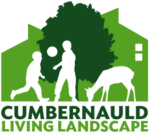INNS & Garden Escapees
Invasive Non-Native Species (INNS) and garden escapees are one of the five top contributors to biodiversity loss.
They cost the Scottish Government approximately £250 Million pounds each year and shockingly £2 Billion pounds for the UK Government. This value is suspected to be highly underestimated with costs much higher than stated, and ultimately this is a cost absorbed by us the tax payer. INNS and garden escapees damage our soils and watercourses, can be toxic to wildlife, people and pets and spreaders of disease and they also out compete our native species for food, light, nutrients and space. This is not just a Scottish or UK problem it is a global problem with countries all over the world fighting to halt the decline and prevent further loss of biodiversity.
Garden escapees are the latest threat to our valuable greenspaces. In our discussions with people in the town we have found that many believe discarded garden waste will rot down and disappear that nature will be able to cope and not be affected. This could not be further from the truth. Garden escapees are quickly becoming new invasive species with the INNS list expanding every year. They are spreading and causing harm to our environment, and ultimately to our wildlife and us.
That plant chucked over the fence is now someone else’s problem that will spread right back into the garden it came from, that action is also now a criminal offence and the landowner can take action, but here is the good news! It is so easy to help us win this fight, garden plants that are not invasive can be donated in the local area, or put in the brown or black bin, better yet use it for composting and get free soil for your plants.
Invasive Non-Native Species need to be cut down and left to rot in an elevated position, have the roots and branches off the ground until it decays fully, If it is left on the ground roots begin to grow and the problem returns. In the case of Invasive Non Native Species, the plant must remain where it is cut down from, moving it is against the law. This can be an exciting science experiment for you and/or for kids – how long does it take to rot, what species if any help it to decompose, the wonder of scientific opportunities awaits.
Our wildlife is incredibly vulnerable, they depend on native species to thrive for food and shelter, introducing invasive non native plants and trees is having a devastating effect on our biodiversity. How much more do we need to lose before it is too late?
We need you, will you help us, will you help our wildlife?
What we have found so far
Since April, Development Officer, David has been out with volunteers recording instances where INNS and garden escapees are spreading on our parks, reserves and greenspaces to highlight how common it is across the town. Those sessions have now come to an end and we are now exploring how to refine the app for recording to make it user friendly and fit for purpose. In short we need data that is purposeful, reliable and can be utilised to help locate, identify and manage INNS and garden escapees. We aim to have this app available for the new Nurturing Natural Connections project next year.
You can see how many INNS and garden escapees have been identified in our cracking map below. A good few sessions have been held to remove INNS and garden escapees too, we are in the process of figuring out how to record the management, but we have a great team and I am confident we will have it in place by the end of this year for testing.
Until then, compost or dispose in the brown/black bin unwanted garden plants or cut down to rot, elevated off the ground for invasive species.
